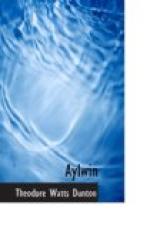‘Pre-Raphaelites?’ said Wilderspin, ’the Master rhymes, madam, and Burne-Jones actually reads the rhymes! However, they are on the right track in art, though neither has the slightest intercourse with the spirit world, not the slightest.’
‘My exploits as a painter have not been noticeable as yet,’ I said; ’but an amateur may know what a barley-field is. That is one before us. He may know what a man in love is; Boaz there is in love.’
‘I wish we could see the woman’s face,’ said Sleaford. ’A woman, you know, without a face—’
‘Come and see the predella of “Faith and Love,"’ said Wilderspin, and he moved towards an easel where rested the predella, a long narrow picture without a frame. My mother followed him, leaving me standing before the picture of ‘Ruth and Boaz.’ Although the head of Ruth had been painted out, the picture seemed to throb with life. Boaz had just discovered the Moabitish maiden in the gleaming barley-field, as she had risen from stooping to glean the corn. Two ears of barley were in one hand. In the face of Boaz was an expression of surprise, and his eyes were alight with admiration. The picture was finished with the exception of the face of Ruth, which was but newly sketched in. Wilderspin had contrived to make her attitude and even the very barley-ears in her hand (one of which was dangling between her slender fingers in the act of falling) express innocent perturbation and girlish modesty.
II
At length I joined the others, who were standing before the easel, looking at the predella which, as Wilderspin again took care to tell us, had been removed from the famous picture of ‘Faith and Love’ we were about to see in the next room—’the culmination and final expression of the Renascence of Wonder in Art.’
‘Perhaps it is fortunate,’ said he, ’that I happen to be working at this very time upon the predella, which acts as a key to the meaning of the design. You will now have the advantage of seeing the predella before you see the picture itself. And really it would be to the advantage of the picture if every one could see it under like circumstances; it would add immensely to the effect of the design. Look well and carefully at the predella first. Try to imagine the Oriental Queen behind that veil, then observe the way in which the features are expressed through the veil; and then, but not till then, come into the adjoining room and see the picture itself, see what Isis really is (according to the sublime idea of Philip Aylwin) when Faith and Love, the twin angels of all true art, upraise the veil.’
He then turned and passed through the folding-doors into a room of great size, crowded with easels, upon which pictures were resting.
The predella before me seemed a miracle of imaginative power. At that time I had not seen the work of the great poet-painter of modern times whom Wilderspin called ‘the Master,’ and by whom he had been unconsciously inspired.




